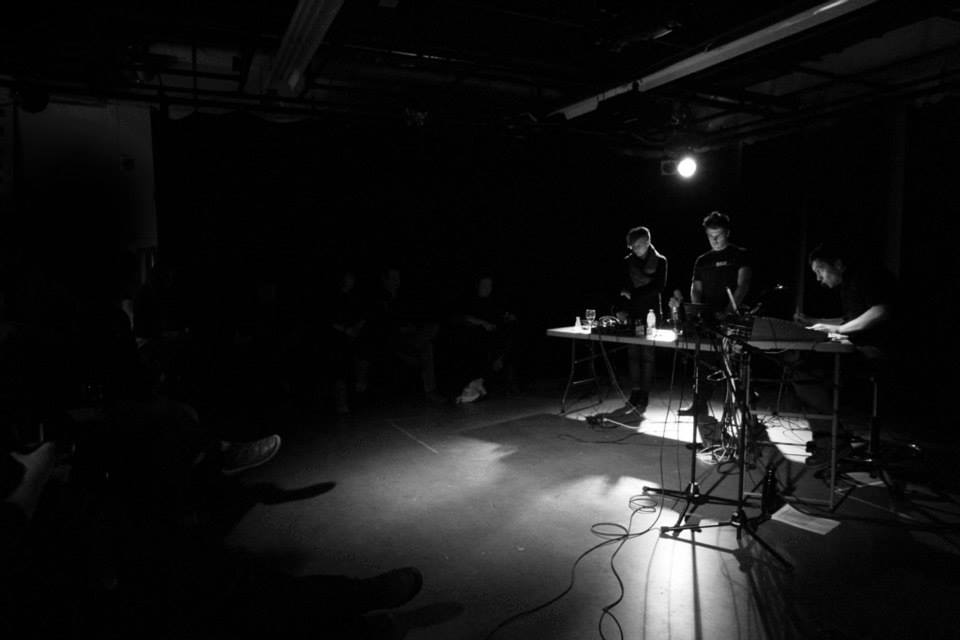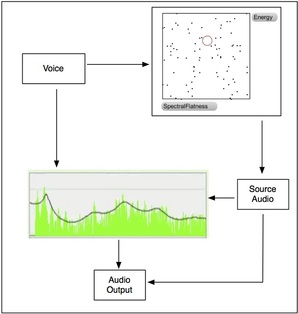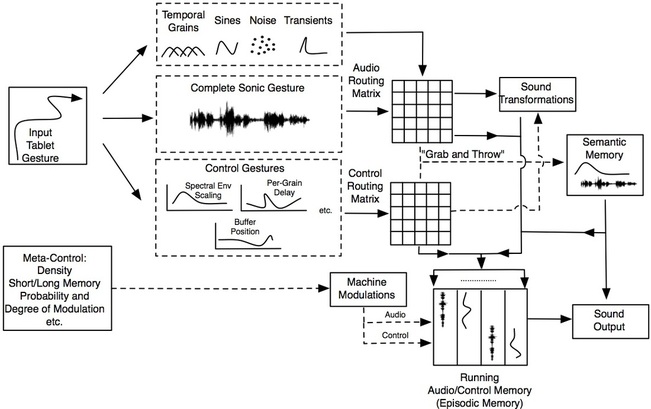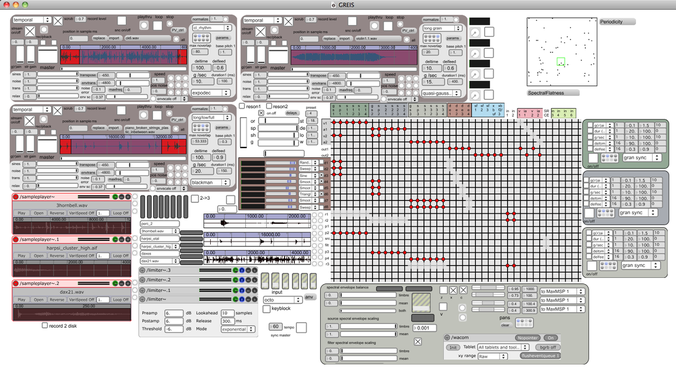Elemental Agency is a piece concerned with an emergent gestural language that manifests across movement, sound and light. Rather than sound/light articulating movement, or movement driving media, the approach builds outward from gestural metaphors as a point of shared intersection for these phenomena. The work draws upon the metaphorical constructs of Japanese Godai and Indian Vaastu Shastra theories of five elements: earth, water, wind, fire and void/space. Working with conceptual metaphors drawn from these traditions, constraints are provided to the dancers of embodying a given element as a collective – a texture of movement, rather than a singular human entity, that manifests the non-human agency of a given element. Motivations related to world, body, motion, emotion and enaction are given: earth as stubbornness and resistance to change, wind as expansive, elusive and compassionate, fire as energetic and forceful, etc. Using machine learning methods, the sonic interaction designers seek to capture moments of gestural expression and fuse this with sounds that similarly embody a given elemental quality/profile. Negotiation between art forms leads to a collective choreography and sound design that emerges from the embodiment of the nonhuman elements and the mediation of the machine agents. Visual projection functions as both lighting and enhancement of embodied experience in space, rather than screen-oriented media experience. Spotlights both enhance elemental qualities as well as embodying behaviours that align with the constraints of the element metaphors: rigid tracking of movement within earth state, amorphous following within water state, tendency towards consumption in fire state, etc.
The pieces moves through short movements of distinct elements: water swells and then recedes into earth, which tectonically shifts before dispersing to the wind, dying down to invoke fire. Gestures and movement are recognized and mapped to sound and light output. The collective texture of these elements then shifts to the individual gesturality of each dancer, who singularly choose to embody a given element: moving from the collective texture of mono-element to the collision and transformation between elements, passing between dancers. The pervasive aether of machine listening recognizes gestures captured throughout the four-elements sections and re-inject loops of these into the performance: this aether ever-listening to elements, and re-performing its understanding of each dancers elemental offerings. Increased density and destabilization of dancers’ elemental transformations lead to an ascendance into the void: pure energy, beyond the everyday, a distribution/suspension/expansion of presence and expression. Void is devoid of any object-hood or gestural points of reference.
The piece rests in void state during its installation period. If audience members interact (browser via laptop or mobile device) with the elemental portal, they may bring the piece back into the world of a given elemental state. The performance space then invites interaction from audience.











Credits:
Doug Van Nort: conception, direction, system composition, void state sound/interaction design
Vanessa Boutin, Holly Buckridge, Shaelynn Lobbezoo, Joshua Murphy, Paige Sayles, Marie-Victoria de Vera: emergent and collective choreography, dance
Yirui Fu: spotlight visual/behaviour design
Akeem Glasgow: kinect tracking and mapping to visuals
Rory Hoy: earth state sound/interaction design
Ian Jarvis: fire state sound/interaction design
Kieran Maraj: water, wind states sound/interaction design
Michael Palumbo: mobile audience interaction,network architecture programming
Mingxin Zhang: spotlight visual/behaviour design
Additional References:
Van Nort, D. “Gestural Metaphor and Emergent Human/Machine Agency in Two Contrasting Interactive Dance/Music Pieces”. Proceedings of the 2020 International Symposium of Electronic Arts (ISEA), 2020.
Jarvis, I., D. Van Nort. Posthuman Gesture, in Proc. of the International Conference on Movement and Computing (MOCO), 2018.
Triple Point – Pauline Oliveros, Doug Van Nort, Jonas Braasch – was an improvising trio whose core instrumentation was soprano saxophone, greis/electronics and V-accordion. The name refers to the point of equilibrium on a phase plot, which acted as metaphor for our improvisational dialogue. Our musical interaction was centered around an interplay between acoustics, physically-modeled acoustics (v-accordion) and electronics. Van Nort captured the sound of the other players on-the-fly, either transforming these in the moment to create blended textures or new sonic gestures, or holding them for return in the near future. Oliveros changed between timbres and “bended” the intended factory sound models through her idiosyncratic use of the virtual instrument, while Braasch explored extended techniques including long circular-breathing tones and multiphonics. This mode of interaction has resulted in situations where acoustic/electronic sources are indistinguishable without very careful listening, while others times this becomes wildly apparent. This continual, fluid morphing is a product of Deep Listening and living in the moment.
“phase/transitions”, a 3-CD set of unedited live improvisation ranging from 2008-2012, was released by Pogus Productions in September 2014. The release features Chris Chafe as a special guest on six tracks.
The trio collaborated on the composition/improvisation project “Quartet for the end of Space” with Francisco López in 2010/2011, also available on Pogus.
In 2009, Triple Point released “Sound Shadows” on the Deep Listening label, which documents a quartet improvisation with Stuart Dempster.
The trio performed together countless time since their inception in 2008, in a variety of festivals and galleries, over the internet with the trio dispersed around the globe, and in experimental exploration of electroacoustic technologies such as machine improvising partners (Van Nort’s FILTER system), automated conducting systems and immersive spatial sound environments based on acoustic modeling of unique spaces.












Triple Point Was:
Pauline Oliveros – accordion/v-accordion
Doug Van Nort – greis/electronics, voice
Jonas Braasch – soprano saxophone
Further Reading:
Doug Van Nort, Multidimensional scratching, sound shaping and Triple Point. Leonardo Music Journal, vol. 20, December 2010.
In 2014, while a Banting Fellow at the Topological Media Lab, I curated two parallel series – one focused on performance and the other on discussion/workshopping/presentation of ideas.
Topological Improvisations was a series presenting improvisations across media, that explored unique topologies of performance: modes of continuity, connectedness and differing boundary conditions, between players and with the space itself. I also took part as a performer in several installments of the series.
These included:
Volume 1: A/V QUARTET ++1: Immersive sound and video, featuring solo/duo/quartet/quintet configurations drawn from: If, Bwana (electronics, objects) / Doug Van Nort (voice, electronics) / Katherine Liberovskaya (live video) / Éric Létourneau (synths, gamelan, wind instruments) / Akunniq (the dog)
Volume 2: TRANSMISSIONS & RESONANCE: A set of improvised sonic explorations, transmission to/from the boundaries of the space. Meditations on the continuity and connectedness of resonance. Julien Ottavi, Erin Sexton, Doug Van Nort in solo/trio combinations.
Volume 3: QUARTETTO TELEMATICO: Pauline Oliveros, Doug Van Nort, Chris Chafe, Jonas Braasch, four site telematic performance for Frontiers Festival, Birmingham, UK.
Volume 4: SINGING IN PLACE: Singing In Place is a live performance. Improvised singing – with and without electronic processing – is used to convey the memory of walks taken. The voice is often combined with field recordings and texts. Viv Corringham solo and in duo with Kathy Kennedy.
Volume 5: MOVING SPACES: Moving Spaces (2002) – Christian Wolff (b. 1934) – Christian Wolff wrote Moving Spaces in 2002 for Loose Time, a work by the Merce Cunningham Dance Company. The piece is rooted in improvisation, ruled by indeterminacy, and energized by noise, silence, and electronic manipulation. The piece was performed by seven improvisers from the Montreal scene: Zach Hale (electronics), Emily Lair (french horn), Molly Wreakes (french horn), Duncan Campbell (trumpet), Felix Del Tredici (bass trombone). Joining them were dancers Bailey Eng and Samantha Rust.
Topological Re-Mediations were a series of workshops and lectures that explored new modes of collective play and co-creation, speculative inquiry and technico-aesthetic innovations in the context of responsive environments.
These included:
Volume 1: HMMM Vocal Workshop with Kathy Kennedy
Volume 2: “Sweet on the Spot” – A presentation and participatory demo on spatial audio with Peter Plessas (IEM, Graz)
Volume 3: Threads: Oana Suteu Khintirian and Navid Navab lecture/demo on “Threads”: Threads is exploring new haptic ways of engaging with paper. Dwelling with the mnemonic dimension of the written word, it puts under the magnifying glass the acts of reading and writing in an intricate play of sensorial relations.
Volume 4: Orbital Resonace: Discussion and Performance. A Research-Creation Project by Margaret Jean Westby and Nikolaos Chandolias In Collaboration with Anne Goldenberg and Doug Van Nort.
Volume 5: Mother of Balloon Music: Judy Dunaway gave a lecture/demonstration about the amazing ways that balloons function as sound makers, offering some history of the balloon in experimental music. This was followed by an audience performance of her “Balloon Symphony No. 2.”
Volume 6: Radius: Jeff Kolar discussed his ongoing curatorial project Radius, an experimental radio broadcast platform based in Chicago, IL, USA. Radius features a new project monthly with statements by artists who use radio as a primary element in their work. Radius provides artists with live and experimental formats in radio programming. The goal is to support work that engages the tonal and public spaces of the electromagnetic spectrum.






















Credits:
Curation and Performance:
Doug Van Nort
Performers/Presenters:
Various – see above.
Event Promotion, Flyers, Web pages:
Nina Bouchard, Lauren Osmond
Inspirator, Lab Context:
Sha Xin Wei and the Topological Media Lab
Created for the Summer Solstice 2014 at Socrates Sculpture Park in Queens, NY and commissioned by Norte Maar. This piece involved the placement of hydrophones in the east river, and a process of improvisational auscultation of the underwater environment and transformation of the sound discovered on this longest day of the year.
This piece was described well (aside from fact these were live audio streams and not recordings!) in 2014 by Hyperallergic:
“Doug Van Nort presented an improvised performance based on audio recordings taken from the East River, on which the park is settled. The improvisation shifted between murky drones and deep earthly noise, as well as the occasional rhythmic popping. The sounds were entirely derived from signals transmitted from hydrophonic microphones placed in the river, displacing and relocating the unheard sounds of the aquatic environment above the surface.”
This quartet project involves Pauline Oliveros, Francisco López and Jonas Braasch. It brings together devoted improvisers on one hand and electroacoustic composers on the other. The project explores a new synthesis of improvised electro/acoustics, and studio-based composition. The process has been to begin with free improvisations, from which recordings are then crafted into personal compositions by each member (which have then found their way back into performance, thereby closing the loop). We released an album on Pogus in April 2011, which has received some very nice reviews. This can be purchases directly from me, from Pogus or at the iTunes music store.
Also, my piece Outer was featured in the film Leopardi (aka il Giovane Favoloso), directed by Mario Martone and starring Elio Germano. It was used to underpin an intense scene featuring only the main character, in the film’s final 3.5 minutes.
Excerpts of my pieces from Quartet for the end of Space (Pogus, 2011):
While living closer to NYC, I had an active duo collaboration with composer Al Margolis, also known as If, Bwana (I am sure we will re-convene and pick back up when the moment presents itself.) In this project, Al uses acoustic instrumental recordings as source material and I begin from very small fragments of various recordings. A musical feedback loop is formed and sonic materials are traded, as I capture the large chunks of sound that Al has produced in order to re-sculpt and define new gestures, while Al captures my sound in order to transpose, stretch and loop the output. We have a release on Zeromoon (2011) that presents an unedited live performance in it’s entirety. “The result is a rich palette of sound informed by classic electronic composition, minimalist drone works, and modern noise music. Structure to chaos, drone to acoustic collages…”.
Here is an excerpt from that release:
I call this project FILTER: Freely Improvising, Learning and Transforming Evolutionary Recombination system. It is both a design of an “intelligent” interactive machine performer and a generative composition – a system endowed with a universe of possible musical actions that fits with my own aesthetic and approach to electroacoustic improvisation. My interest was in creating a system that could listen to the textural and gestural qualities as well as the stylistic tendencies of a performer and to take musical actions, improvising as a partner with the player and using their own audio as source material. FILTER does this by recombining, transforming and re-presenting this material in a radically new form as a new musical offering, in dialogue with its human partner. In some sense, I consider this as a project that is a reflection and genetic re-creation of what I would do as an improvising “laptop musician” with my GREIS instrument — wherein I often capture sounds on the fly while transforming them.
Below is an excerpt of a performance sesions with FILTER and Sam Sowyrda (of Cloud Becomes your Hands and the Dan Deacon live band). I like this one because Sam uses a wide timbral variety of objects, and because he is a Deep Listener who respects the system as a fellow player. This is clear in that the dynamics are well matched; also I find the interplay quite nice wherein Sam sometimes takes the lead and FILTER created textural layers or loops, while other times it switches to more varied events and Sam creates his own rhythmic “loops” in support of this. Listen for the materials selected by the machine, and realize that there is no human hand in terms of decision making (content, dynamics, timing, etc.).
A second, more recent example is a set with percussionist Paul Hession at Cafe OTO in London, as part of the Musical MetaCreation event (“MUME @ NIME”), curated by Ollie Bown. In this excerpt, sometimes FILTER is very clearly doing machinic things (e.g. long drone, phase vocoder-sounds) and at other times it is creating new patterns from the sonic material Paul had played previously. It listens to what he is doing in the moment and plays with him. I like this section because they collectively modulate their intensity and density.
Finally, I approached the trio Triple Point as an important test bed for developing FILTER. Here are some tracks from our 3-CD set “phase/transitions” which feature the system as a fourth performer:
GREIS (pronounced “grace”) is the Granular-Feedback Expanded Instrument System. my ever-evolving performance system and digital music instrument that is now 16 years in the making. GREIS is Created in Max/MSP – a collection of many custom modules from various sub-projects I’ve done over the years. The system focuses on sculpting and re-shaping recorded or live-captured sounds through spectral and textural transformations, largely performed with hand gestures on a Wacom tablet (right hand) while modulating the sound or the nature of the control/mapping in some way (left hand). The unit of a “grain” – which may be e.g. a temporal fragment, a single partial or a transient component – is dispersed to different processes and fed-back through the system. GREIS includes granular and spectral analysis/synthesis, complex mapping techniques and generative processes that surprise me with machine-based decisions, forcing me to react in the moment. The system is intended for the total flexibility of free improvisation, and I often play with acoustic musicians – sometimes using their sound as source material. In other projects and solo, I work with particular sets of recorded material, grouped according to their qualities and re-called in the moment of performance for sculpting and transformation. A more recent focus of this work is in designing ways to navigate large databases of sound files grouped by their sonic qualities, and re-call these in an improvised fashion. (A form of “timbre space” navigation). This manual approach to sculpting recorded sound is something I refer to as multidimensional turntablism. In more recent years, I have begun performing with voice, both as source material and also as another means to sculpt recorded sounds, using audio mosaicing techniques combined in a unique way with vocal-cross synthesis methods, as illustrated in the below diagram:

In performing with this system I am focused not only on improvised sonic sculpting using hands and voice, but also interacting with the immediate past in a way that is nonlinear and which presents new gestural modulations into the musical mix in order to create coherent sonic structures over time. This performance practice with GREIS thus leads to my being able to immediately shape sound objects in both dramatic and subtle ways, and to achieve a particular musical structure by building loops, textures and layers “by hand” in collaboration with the machine. Sonic gestures are thus a very essential part of my work, while theatrical gestures are not my central concern. I think of the system as a complex dynamical system that has a memory and hysteresis, like an acoustic instrument. From an interaction design point of view, I think in terms of metaphors when designing and performing with GREIS: sculpting, navigating but also “grabbing” and “throwing” sounds in performance. Below is a diagram that represents the internal memory and sonic gestural representations of the system:

Meanwhile, here is a screen shot from one possible orientation of the GREIS software:

Sound examples of me performing with the system can be found on the Triple Point project page. More detailed information on the design of GREIS can be found in the following publication:
Doug Van Nort, Pauline Oliveros and Jonas Braasch, “Electro/Acoustic Improvisation and Deeply Listening Machines”, Journal of New Music Research, 42(4), pp. 303-324, December 2013.